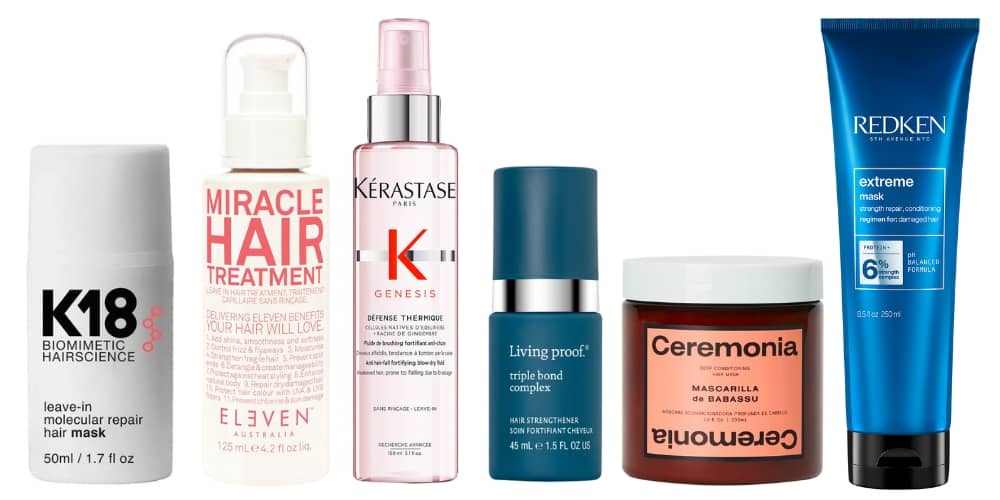A busy life means haircare can sometimes end up last on the list of priorities.
But then suddenly styling your hair in the morning becomes more of a battle, or your usual ‘do starts to look decidedly more unkempt than normal.
Sometimes all you need is a good trim, but sometimes the neglect means you’ve caused damage to your strands that’s hard to reverse.
Relying on hot tools as a quick fix to tame and smooth a polished style or create those perfect, undulating waves can also have a significantly detrimental impact. Particularly if you’re using a tool that gets very hot and you’re not guarding strands each time with a protective styling product.
Damaged hair shows up in a variety of ways. Sometimes these can be improved or remedied with the use of a molecular bonding product that strengthens bonds in the hair fibre or deep hydration, but sometimes, like in the case of split ends, the only solution is a cut.
In any case, the signs of damage are worth keeping an eye out for, as they’re signals to get on top of the issue before it gets worse.
So what should we look for, to know our hair is crying out for help?
Split ends
If you notice your hair beginning to fray at the ends or they look thin and frizzy, there’s a good chance you’re dealing with split ends.
One of the most common signs of damage, split ends, technically known as trichoptilosis, occur when the hair shaft splits into two or more fragments at the tip. This happens when the protective outer layer of the hair cuticle is damaged or worn away, leaving the inner core exposed and weakened making the each strand vulnerable to splitting and snapping.
When this happens it’s rarely a clean break, but a jagged end with splits and ridges. If left unaddressed, these jagged ends can continue to split further up the hair shaft, causing more damage.
The best idea is to have regular trims but it’s often caused by a lack of moisture, so using hydrating shampoo and conditioners is also a good idea. Distributing a hair oil or serum between your fingers and running through your ends can help add nourishment and conceal the appearance of split ends.
Dry and brittle texture
Damaged hair tends to feel dry, rough, and brittle. It may lack the smoothness and softness of healthy hair.
Dry hair lacks moisture and if it’s really damaged it lacks the ability to hold onto that moisture. So your first step is to instigate a good moisture routine with extra hydrating products and add in a nourishing hair mask once a week or so, but if that doesn’t help you may need to consult a professional.

Best products for damaged hair (L-R): K18 Leave-in Molecular Repair Hair Mask; Eleven Miracle Hair Treatment; Kérastase Genesis Anti-Hairfall Heat Protectant Spray; Living Proof Triple Bond Complex; Ceremonia Deep Conditioning Hair Mask; Redken Extreme Mask
Dullness
The cuticles of your hair are what make it shiny and when those cuticles are damaged, your hair becomes less reflective.
A good indicator is that after washing your hair, it should be brighter than when it was dirty. If it’s dull, you may have damage, particularly heat damaged hair. It’s worth also doing a double cleanse, or using shampoo twice in a row, to ensure the dullness isn’t cause by product buildup or your scalp’s natural oils.
Dryness also contributes to dull hair. Damaged hair doesn’t properly maintain moisture, leaving your tresses dehydrated and prone to breakage.
If you’ve coloured your hair, damaged hair may show quicker colour fading and uneven colour distribution. Ask for a protective treatment with your next service.
Breakage
Healthy hair can stretch and return to its original state, while damaged hair may not bounce back and can break when stretched. This breakage often prevents your hair growing as long as you’d like.
Breakage and strands snapping is likely due to a lack of this elasticity, meaning hair is in a fragile state and will not stretch much without breaking. If you notice breakage throughout your head you may have experienced over-processing from a colour service or a chemical treatment.
Using too-tight hair ties can also contribute to breakage. Try using a claw clip or loose silk scrunchie instead.
Frizz and flyaways
Excessive frizz and flyaways are often a result of damaged hair, as the cuticle layer becomes rough and raised. Make sure you’re not over washing your hair, layer good quality hydration in the form of conditioner and a regular hair mask and always choose styling products that prep your strands well.
Scalp issues
Sometimes, an unhealthy scalp can lead to damaged hair. Look for signs of dandruff, itchiness, or excessive oiliness. Seek out treatment shampoos and scalp treatments that are designed to nourish and balance the scalp.
If you struggle with keeping good balance and find hair feels greasy at the top and dry everywhere else, fear not. There are a number of shampoos and conditioners designed specifically for oily scalps and dry ends.
Hair loss or thinning
Thinning around the hairline and throughout the head can have a variety of causes. Though genetics have a role, other variables like stress, nutritional deficiencies, medication and hormonal changes or imbalances can play a part.
Even tying your hair too tightly, too often or for too long, can contribute to traction alopecia, a form of acquired hair loss that results from prolonged or repetitive tension on the scalp hair.
Because of the variety of causes, if you notice thinning hair it’s important to look at the bigger picture before undertaking any treatment for hair loss. This includes undertaking professional advice from your GP or a trichologist.
In general, experts also suggest ensuring you’re using the right type of quality haircare products for your hair type and focusing on cleansing, nourishing and increasing blood flow to the scalp. Avoid restrictive diets and ensure you eat a wide variety of nutritious foods and get enough iron and omegas.







